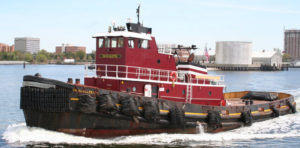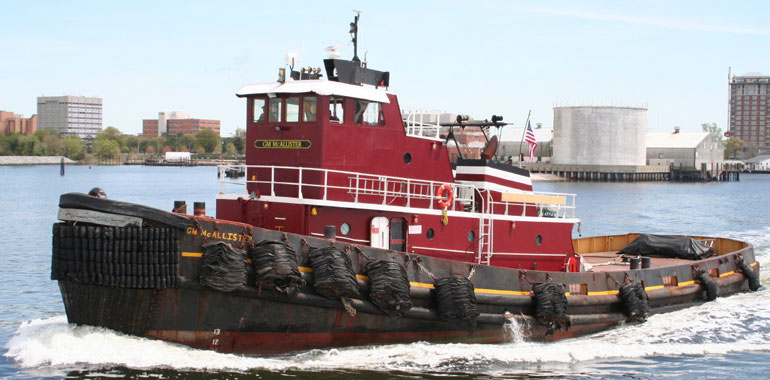
The bulk carrier Ijssel Confidence backed toward a turning basin on the Elizabeth River in Chesapeake, Va., with two tugboats ready to assist as needed.
The 590-foot ship, under the direction of a docking pilot, picked up speed over the next 15 minutes. G.M. McAllister, a 4,000-hp tug positioned at the stern, became boxed in and hit infrastructure at the NGL Energy Partners terminal infrastructure.
The incident on Sept. 23, 2019 at 0657 caused nearly $1.5 million in damage, nearly all to the terminal. There were only negligible effects on the tugboat. None of the four tugboat crew was injured and there was no pollution.
National Transportation Safety Board (NTSB) investigators determined Ijssel Confidence backed too fast for the docking pilot to effectively use the two conventionally driven tugboats. The agency’s report also found a lack of communication between the docking pilot and the two tugboat crews contributed to the incident.
“The G.M. McAllister captain and the docking pilot told investigators that there had been gaps in their communication,” the NTSB report said. “Had they both communicated better, and had the ship proceeded in a speed more appropriate for the tugboats, this accident could have been avoided.”
The NTSB did not identify the tugboat captain or docking pilot, who worked for the Association of Virginia Docking Pilots. Attempts to reach the pilots group and McAllister Towing for comment on the NTSB findings were not successful.
Ijssel Confidence, registered in Portugal, arrived at Kinder Morgan’s Elizabeth River Terminal No. 2 on Sept. 20. The ship was departing for Charleston, S.C., to discharge its cargo of fertilizer on the morning of the incident.
Two pilots boarded the vessel within five minutes of each other starting at about 0615. The docking pilot was to guide the ship away from the terminal to a point about 5 miles downriver. From there, a pilot from the Virginia Pilot Association would bring the ship into Chesapeake Bay.
G.M. McAllister and its 4,000-hp counterpart Nancy McAllister would assist the ship off Kinder Morgan’s berth. Ijssel Confidence would then back west-northwest toward the turning basin at Money Point. There, the tugs would spin the ship roughly 90 degrees counterclockwise for departure.
This maneuver might have been clear to the docking pilot, but he never explained it to the McAllister tug crews. “G.M. McAllister’s captain said that he didn’t know the docking pilot’s plan, and investigators did not hear any master/pilot exchange on the VDR, nor did they hear any discussion of the undocking evolution with the tugboat captains, the ship’s master or the state pilot,” the NTSB said.
The ship got underway at 0639. G.M. McAllister took position at the starboard stern while Nancy McAllister was off the bow. The docking pilot ordered the ship’s engine to dead slow astern. Six minutes later, Ijssel Confidence was moving west at 1.8 knots. Four minutes after that, the speed increased to 2.5 knots as the ship moved west-northwest. The pilot ordered the engine stopped at 0652, but the ship’s speed increased to 3.2 knots a minute later.
G.M. McAllister pushed full ahead on the ship’s stern as it approached the NGL Energy Partners terminal on the south side of the river. The docking pilot ordered him to stop. The tug, pushing ahead while also trying to keep pace with the ship’s sternward movement, effectively tugged Ijssel Confidence toward the terminal.
The docking pilot then ordered G.M. McAllister to tuck alongside the hull as the ship approached the facility. The tug captain told investigators he twisted his vessel to come against the ship, with its bow toward Ijssel Confidence’s stern.
“At this point, the tug was not pushing the ship any longer, but rather Ijssel Confidence was pulling the tug” toward the terminal, the NTSB said. Moments before impact the tug repositioned itself, with its bow facing the ship’s hull.
“(As) the ship approached the berth structure, (G.M. McAllister’s) port quarter first hit the piling of the easternmost mooring dolphin and then, when the tug came ahead, struck the walkway between the easternmost mooring dolphin and the next dolphin to the west,” the NTSB said.
Neither pilot ordered the tug to change positions before the impact. It is not clear, based on the report, if the tug would have avoided the shoreside infrastructure if it remained tucked against the hull. Investigators determined the tug hit the infrastructure because the docking pilot “placed the tugboat in such a position that the tugboat was caught between the dock and the side of the ship.”
Better communication could have helped the tug crews and pilot get on the same page. This was especially relevant, the NTSB suggested, because the docking pilot typically worked with a different tug operator. The pilot also was accustomed to working with azimuthing stern drive tugboats, which perform differently than conventional tugs.
The NTSB reviewed nine undocking maneuvers from the same facility and found Ijssel Confidence exceeded the average speed of these ships by more than 1 knot. In eight cases, the pilots chose a course well clear of the NGL terminal. In the ninth case, where the ship approached the terminal, the pilot had two 6,000-hp tractor tugs to assist.
The docking pilot, the report said, “should have been aware that the conventional tugboats were less maneuverable than tractor tugboats, but he neglected to take into account the conventional tugboats’ reduced effectiveness and the additive effect to the ship’s speed.”
“Whatever the cause,” the report continued, “the ship’s speed made it difficult to effectively use the tugs to position the ship laterally in the waterway.”

